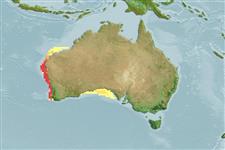Classification / Names
आम नाम | उपशब्द | Catalog of Fishes(वर्ग, प्रजाति) | ITIS | CoL | WoRMS | Cloffa
>
Perciformes/Scorpaenoidei (Scorpionfishes) >
Platycephalidae (Flatheads)
Etymology: Platycephalus: Greek, platys = flat + Greek, kephale = head (Ref. 45335); orbitalis: Name from Latin for eye, referring to its characteristic feature of a narrower interorbit..
Environment: milieu / climate zone / depth range / distribution range
पारिस्थितिकी
समुद्री बेनथोपिलाजिक; गहराई सीमा 50 - 144 m (Ref. 83297). Tropical
Easrtern Indian Ocean: Western Australia,
आकार / वज़न / Age
Maturity: Lm ? range ? - ? cm
Max length : 33.3 cm पुल्लिंग / अलिंग; (Ref. 83297)
Short description
आकृति विज्ञान | मौरफोमैटरिक्स
पृष्ठीय रीढ़ (सम्पूर्ण): 8 - 9; पृष्ठीय सौफट रेज़ (सम्पूर्ण): 13; ऐनल सौफट रेज़: 13. This species is distinguished by the scalloped margin of the interopercle; infraorbitals and preopercle with well developed skinny sensory tubes, mostly covering cheek region, except for anteroventral region; body and head with no distinct large spots and bands dorsally (Ref. 83297).
Life cycle and mating behavior
परिपक्व अवधि | पुनरुत्पत्ति | मछलीऔ का अंडे देना | अंडे | Fecundity | लार्वा
Imamura, H. and L.W. Knapp, 2009. Platycephalus orbitalis, a new species of flathead (Teleostei: Platycephalidae) collected from Western Australia. Zootaxa 2271:57-63. (Ref. 83297)
IUCN Red List Status (Ref. 130435)
Threat to humans
Harmless
Human uses
अधिक जानकारी
आम नामउपशब्दचपायचयपरभक्षीईकोटोकसीकोलौजीपुनरुत्पत्तिपरिपक्व अवधिमछलीऔ का अंडे देनाSpawning aggregationFecundityअंडेEgg development
Age/Sizeबाढ़Length-weightLength-lengthLength-frequenciesमौरफोमैटरिक्सआकृति विज्ञानलार्वालारवल गतिकीभर्तीबहुतायतBRUVS
संदर्भजलीयकृषिजलीयकृषि रूपरेखाखींचआनुवंशिकीElectrophoresesहैरेटिबिलटीबीमारीप्रक्रमणNutrientsMass conversion
सहयोगीयोतस्वीरेStamps, Coins Misc.ध्वनिसिगुयटिरारफ्तारतैरने के प्रकारगिल क्षेत्रOtolithsदिमागदृष्टि
साधन
Special reports
Download XML
इंटरनेट स्रोत
Estimates based on models
Preferred temperature (Ref.
123201): 15.8 - 22.6, mean 17.4 °C (based on 28 cells).
Phylogenetic diversity index (Ref.
82804): PD
50 = 0.5000 [Uniqueness, from 0.5 = low to 2.0 = high].
Bayesian length-weight: a=0.00794 (0.00400 - 0.01577), b=3.08 (2.90 - 3.26), in cm total length, based on LWR estimates for this (Sub)family-body shape (Ref.
93245).
Trophic level (Ref.
69278): 3.9 ±0.5 se; based on size and trophs of closest relatives
लौटाव (Ref.
120179): माध्यम, न्यूनतम जनसंख्या दुगनी होने का समय 1.4 - 4.4 वर्ष। (Preliminary K or Fecundity.).
Fishing Vulnerability (Ref.
59153): Moderate to high vulnerability (46 of 100).
